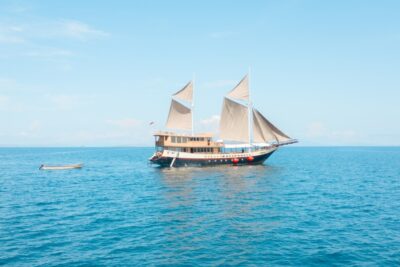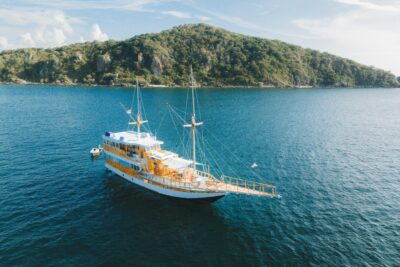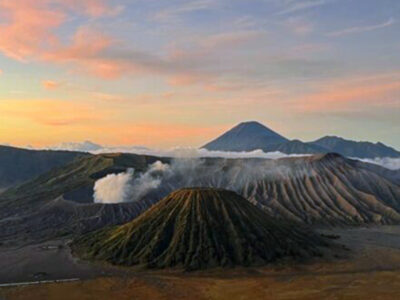Komodo National Park
Komodo National Park is notable as the habitat of Komodo Dragon, the world largest living lizard, its length can up to 3 meters. Though Komodo National Park is made up of rusty-red volcanic hills, savannah and forests. But, its surround waters of seagrass beds, mangrove shrublands and coral reefs are famous for diving and snorkeling.
The Komodo Islands contains various beaches that is perfect for you to swim, snorkeling or diving. There is a beach with "pink" sand, because it is a mixture of white sand combine with red sand, formed from pieces of Foraminifera.
Culture and history info
Komodo Island, located in the eastern part of Indonesia, is famous for being the habitat of the Komodo dragon, the world's largest lizard. However, beyond its iconic reptilian residents, Komodo Island boasts a rich cultural and historical heritage that adds depth to its allure.
Cultural Significance:
Komodo Island is part of the Komodo National Park, which is not only a UNESCO World Heritage Site but also a place of cultural significance for the local communities. The island is inhabited by the Komodo people, who have lived there for centuries and have a unique culture deeply rooted in the natural environment.
The Komodo people have a rich oral tradition, with stories and legends passed down through generations. They have a deep respect for the land and sea, viewing nature as sacred and integral to their way of life. Traditional ceremonies and rituals, often centered around hunting, fishing, and agriculture, play a significant role in Komodo culture.
Historical Background:
While Komodo Island is primarily known for its wildlife, it also has a fascinating history dating back thousands of years. The island and its surrounding areas have been inhabited by humans for at least 2,000 years, as evidenced by archaeological findings such as ancient pottery and tools.
In addition to its indigenous inhabitants, Komodo Island has been influenced by various external cultures over the centuries. The island was part of the trading networks that connected the Indonesian archipelago to other parts of Asia, leading to exchanges of goods, ideas, and cultural practices.
During the colonial era, Komodo Island, like much of Indonesia, came under the influence of European powers such as the Dutch. This period of colonial rule left a lasting impact on the region's economy, politics, and society, shaping its trajectory into the modern era.
Conservation Efforts:
In recent decades, Komodo Island has become a focal point for conservation efforts aimed at protecting its unique biodiversity and cultural heritage. The establishment of the Komodo National Park in 1980 was a significant step in safeguarding the island's natural ecosystems and iconic wildlife, including the Komodo dragon.
Today, the park is managed collaboratively by government agencies, local communities, and conservation organizations to ensure the sustainable management of its resources. Efforts are underway to promote responsible tourism practices that minimize environmental impact while supporting the livelihoods of local residents. In conclusion, while Komodo Island is renowned for its awe-inspiring wildlife, its cultural and historical significance adds another layer of fascination to this remote paradise. From the traditions of the Komodo people to the island's ancient past, Komodo Island offers a glimpse into Indonesia's rich tapestry of culture and history.
Unfortunately no accommodations were found.

Private day trip Komodo NP, meet the world's largest lizard and enjoy the grass-woodland savannah and pristine white sandy beaches that has rich marine biodiversity.

- Location: Komodo NP
- Cruise Type: Open Trip
- Duration: 2,5 days
- Capacity: 20 guests
- Boat Crew: 7
- 4 Cabin Types with AC
- 6 Private Bathrooms

- Location: Komodo NP
- Cruise Type: Open Trip
- Duration: 2,5 days
- Capacity: 21 - 25 guests
- Boat Crew: 9
- 3 Cabin Types with AC
- 8 Private Bathrooms

- Location: Komodo NP
- Cruise Type: Open Trip
- Duration: 2,5 days
- Capacity: 16 - 22 guests
- Boat Crew: 9
- 3 Cabin Types with AC
- 8 Private Bathrooms

- Location: Komodo NP
- Cruise Type: Open Trip
- Duration: Full Day
- Capacity: Red 8 guests, Blue 15 guests

- Location: Komodo NP
- Cruise Type: Open Trip
- Duration: 2,5 days
- Capacity: 10 - 12 guests
- Boat Crew: 6
- 5 Cabin Types with AC
- 5 Private Bathrooms

- Location: Komodo NP
- Cruise Type: Open Trip
- Duration: 2,5 days
- Capacity: 10 - 11 guests
- Boat Crew: 5
- 4 Cabin Types with AC
- 4 Private Bathrooms

- Location: Komodo NP
- Cruise Type: Private Tour
- Duration: 1 Day, 2D/1N, 3D/2N, 4D/3N and 5D/4N
- Capacity: 10 - 11 guests
- Boat Crew: 5
- 4 Cabin Types with AC
- 4 Private Bathrooms
Unfortunately no car rentals were found.




















